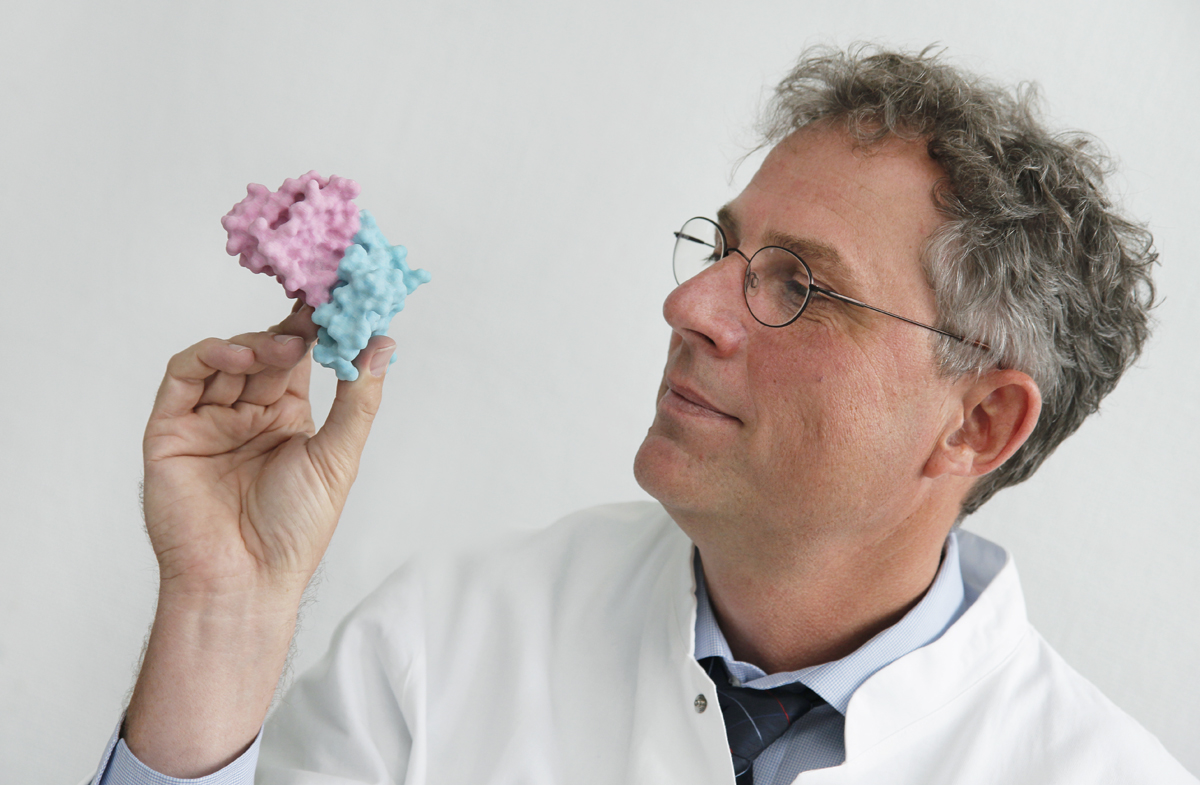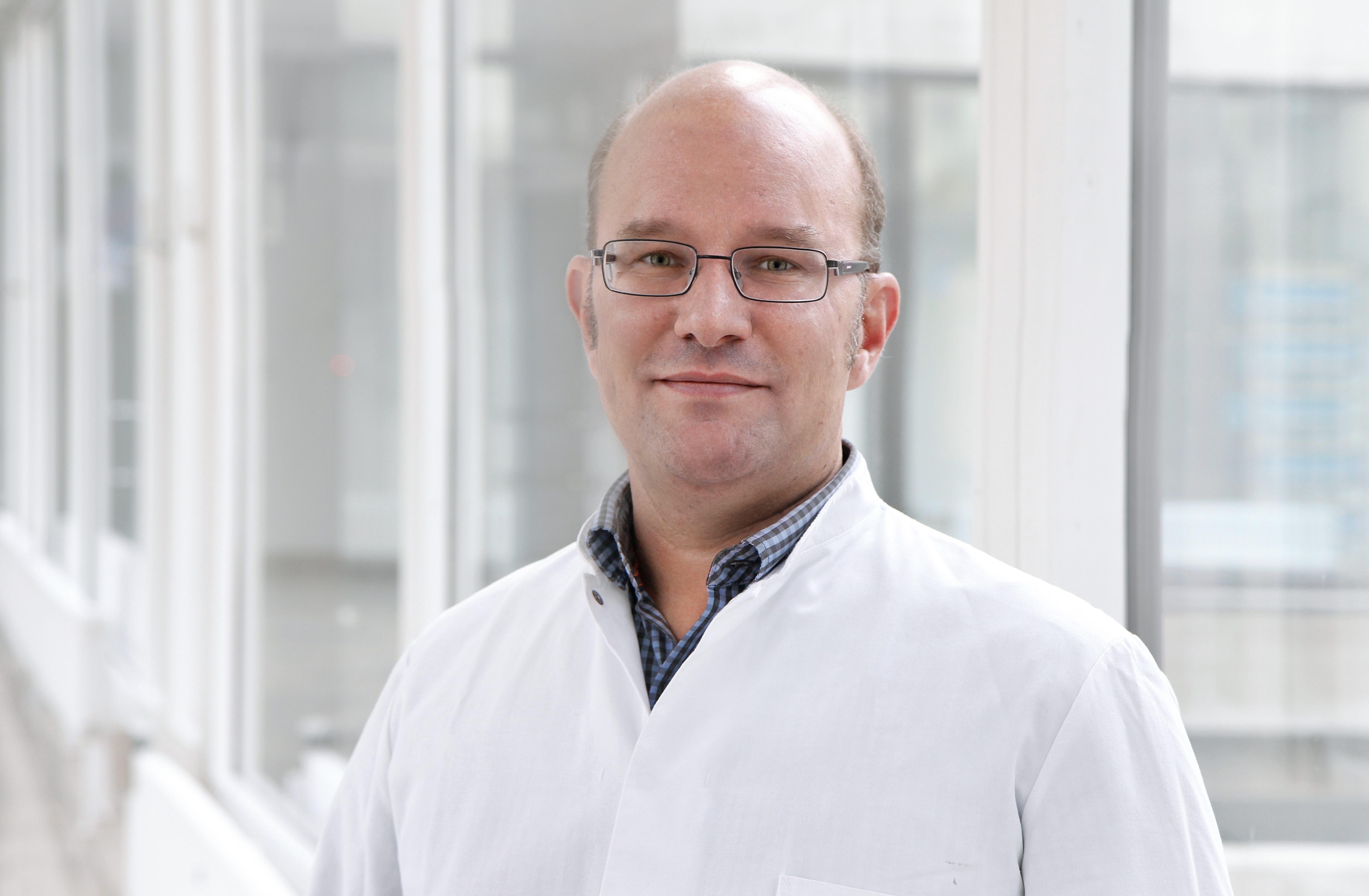Team
Oncology

In recent years, we have focused on the interaction of Helicobacter pylori with the immune system, specifically on virulence factors involved in immune-evasion. Based on promising new antigens identified in recent years, we are also working on developing H. pylori vaccines based on a combination of new antigens, adjuvants and formulations. We are further exploing how H. pylori contributes to carcinogenesis in the stomach, which virulence factors are employed, and which host signaling pathways are activated during cancer initiation and progression.
The canonical Wnt signaling pathway is essential in developmental processes and plays a crucial role in the regulation of epithelial stem cell self-renewal. Deregulation of this pathway is associated with carcinogenesis, particularly in the gastrointestinal tract. We identified a target gene of the Wnt signaling pathway, RNF43, which is selectively expressed in intestinal stem cells and is overexpressed in colorectal adenomas and a subset of colorectal cancers. Mutations of RNF43 have been identified in several tumor types, suggesting an important role for RNF43 as a tumor suppressor gene. Indeed, depletion of RNF43 expression in colon and gastric cells increases their tumorigenic potential (Neumeyer et al. Carcinogenesis 2019). To further explore the function of RNF43 we have generated two mouse models expressing mutated Rnf43. Mutations in Rnf43 lead to gastric hyperproliferation, which is exacerbated upon H. pylori infection (Neumeyer et al. Cancers 2019). We are also analyzing the mutation status of RNF43 in human gastroinstestinal tumor samples to determine the role of RNF43 in colon and gastric cancer.

Colorectal tumors are the central focus our research, ranking amongst the most frequent tumors in Europe and North America. The initiation and progression of cancer involves multiple steps of genetic and epigenetic alterations, including the loss of function of tumor suppressor genes, and the activation of oncogenes. Our clinical research group tries to understand how the altered signal transduction cascades, like the WNT- and the Ras/MAPK-pathways, contribute to tumor progression and metastasis formation. In addition to these cell-autonomous changes, we are interested in the interactions of cancer cells with the immune system, which may be beneficial or even detrimental for the patient. Genetically defined mouse models have the potential to recapitulate human cancer development, and they allow to address the fundamental question how different genes and signalling pathways cooperate to achieve the goal of malignant transformation. The generation and screening of the preclinical murine models is completed by the analysis of human patient samples, e.g., in the form of primary tumor cell cultures.
Selected publications:
Holtorf A (...) KP Janssen. Cell-type specific MyD88 signaling is required for intestinal tumor initiation and progression to malignancy. OncoImmunology (2018) https://doi.org/10.1080/2162402X.2018.1466770
Lobner EM (...) KP Janssen, D Haller. Aberrant ATF6 expression links TRIF-mediated STAT3 activation to colorectal cancer in the context of microbial dysbiosis. Gastroenterology (2018). pii: S0016-5085(18)34816-9. doi: 10.1053/j.gastro.2018.07.028.
Cremonesi E (...) Janssen KP, Borsig L, Iezzi G. Gut microbiota modulate T cell trafficking into human colorectal cancer. Gut (2018) Feb 6. pii: gutjnl-2016-313498. doi: 10.1136/gutjnl-2016-313498.
Raphael BJ (…) Janssen KP (...) Zenklusen JC. Integrated Genomic Characterization of Pancreatic Ductal Adenocarcinoma. Cancer Cell 2017;32:185-203 e13.
Kistner L (...) Janssen KP. Interferon-inducible CXC-chemokines are crucial immune modulators and survival predictors in colorectal cancer. Oncotarget 2017;8:89998-90012.
Geyer PE (...) Janssen KP. Gastric Adenocarcinomas Express the Glycosphingolipid Gb3/CD77: Targeting of Gastric Cancer Cells with Shiga Toxin B-Subunit. Mol Cancer Ther 2016;15:1008-17.
Buchert M, Rohde F (...) Janssen KP. A hypermorphic epithelial beta-catenin mutation facilitates intestinal tumorigenesis in mice in response to compounding WNT-pathway mutations. Dis Model Mech 2015;8:1361-73.
Zeestraten EC (...) Janssen KP. Specific activity of cyclin-dependent kinase I is a new potential predictor of tumour recurrence in stage II colon cancer. Br J Cancer 2012;106:133-40.
Nitsche U (...) Janssen KP. Integrative marker analysis allows risk assessment for metastasis in stage II colon cancer. Ann Surg 2012;256:763-71; discussion 771.
Janssen KP (...) Robine S. APC and oncogenic KRAS are synergistic in enhancing Wnt signaling in intestinal tumor formation and progression. Gastroenterology 2006;131:1096-109.
https://www.chir.med.tum.de/darmzentrum/forschung

Proteases and their natural inhibitors control virtually all processes of life by controlling and remodeling the proteins in the microenvironment of any cell, its receptors, as well as growth factors. Imbalance of proteases and protease inhibitors promotes detrimental inflammatory processes during infections, tumor growth, and cancer metastasis.
We study the non-canonical function of Tissue-inhibitors of metalloproteinases (TIMPs), namely their newly-discovered potential to act, unexpectedly, as a cell signaling-inducing cytokine, which triggers pro-inflammatory function in immune cells as well as other organ-resident cells.
We have identified the multi-functionality of TIMP-1 and could thereby explain the paradox that TIMP-1 correlates with bad prognosis of many diseases, although its canonical anti-proteolytic activity had led to the prediction that TIMP-1 should inhibit them.
We employ a wide spectrum of technologies encompassing all aspects of molecular cloning/genetic engineering, expression-vector design, biochemistry, cell culture including functional cell-assays, metabolic assays, protein-design and purification, flow-cytometry, histology, in silico-modeling, statistical analyses etc. in order to explore new structure-function relationships between TIMPs and their receptors, which we also identify in the process.
Through cooperation with colleagues in the clinic we constantly validate our data with material from the clinic towards a transfer of new knowledge from bench to the bedside.
Examples of publications from our group (PhD students in bold):
- Hermann, C.D., B. Schoeps, C. Eckfeld, E. Munkhbaatar, L. Kniep, O. Prokopchuk, N. Wirges, K. Steiger, D. Häußler, P. Knolle, E. Poulton, R. Khokha, B.T. Grünwald, I.E. Demir, A. Krüger. TIMP1 expression underlies sex-disparity in liver metastasis and survival in pancreatic cancer. J Exp Med 218 : e20210911, 2021.
- Schoeps, B., C. Eckfeld, L. Flüter, S. Keppler, R. Mishra, P. Knolle, F. Bayerl, J. Böttcher, C.D. Hermann, D. Häußler, A. Krüger. Identification of invariant chain CD74 as a functional receptor of tissue inhibitor of metalloproteinases-1 (TIMP-1). J Biol Chem 297 : 101072, 2021.
- Schoeps, B., C. Eckfeld, O. Prokopchuk, J.P. Böttcher, D. Häußler, K. Steiger, I.E. Demir, P. Knolle, O. Soehnlein, D.E. Jenne, C.D. Hermann, A. Krüger. TIMP1 triggers neutrophil extracellular trap formation in pancreatic cancer. Cancer Res 81 : 3568-3579, 2021.
- Eckfeld, C., D. Häußler, B. Schoeps, C.D. Hermann, A. Krüger. Functional disparities within the TIMP family in cancer: hints from molecular divergence. Cancer Metastasis Rev 38 : 469-481, 2019.
- Grünwald, B., B. Schoeps, A. Krüger. Recognizing the molecular multifunctionality and interactome of TIMP-1. Trends Cell Biol 29 : 6-19, 2019.
- Grünwald, B., V. Harant, S. Schaten, M. Frühschütz, R. Spallek, B. Hoechst, K. Stutzer, S. Berchtold, M. Erkan, O. Prokopchuk, M. Martignoni, I. Esposito, M. Heikenwaelder, A. Gupta, J. Siveke, P. Saftig, P.A. Knolle, D. Wohlleber, A. Krüger, Pancreatic pre-malignant lesions secrete TIMP1, which activates hepatic stellate cells via CD63 signaling to create a pre-metastatic niche in the liver. Gastroenterology 151 : 1011-1024, 2016.
- Seubert, B., B. Grünwald, J. Kobuch, H. Cui, F. Schelter, S. Schaten, J.T. Siveke, N.H. Lim, H. Nagase, N. Simonavicius, M. Heikenwalder, T. Reinheckel, J.P. Sleeman, K.P. Janssen, P. Knolle, A. Krüger. TIMP-1 creates a pre-metastatic niche in the liver through SDF-1/CXCR4-dependent neutrophil recruitment in mice. Hepatology 61 : 238-248, 2015.
- Cui, H., B. Seubert, E. Stahl, H. Dietz, U. Reuning, L. Moreno-Leon, M. Ilie, H. Nagase, B. Mari, A. Krüger. Tissue inhibitor of metalloproteinases-1 induces a pro-tumorigenic increase of miR-210 in lung adenocarcinoma cells and their exosomes. Oncogene 34 : 3640-3650, 2015.

Characterization of molecular targets for therapy and identification of molecular determinants for the prediction of therapy response in bladder cancer:
In this project, the group is interested in the evaluation of molecular alterations that allow for stratification of patients in potential responder vs non-responder for specific target therapies in bladder cancer. Methods used are CRISPR-Cas9 gene editing, murine xenograft models, molecular and cell biology assays
Improvement of the replication capacity of oncolotyic adenovirus by identification of combination therapies:
In this project, we identify and characterize target therapies that influence the replicative behaviour of an oncolytic adenovirus
Selected publications:
Tong Z, Sathe A, Ebner B, Qi P, Veltkamp C, Gschwend JE, Holm PS, Nawroth R. Functional genomics identifies predictive markers and clinically actionable resistance mechanisms to CDK4/6 inhibition in bladder cancer. J Exp Clin Cancer Res. 2019 Jul 22;38(1):322. doi: 10.1186/s13046-019-1322-9.
Lichtenegger E, Koll F, Haas H, Mantwill K, Janssen KP, Laschinger M, Gschwend J, Steiger K, Black P, Moskalev I, Nawroth R, Holm PS. The oncolytic Adenovirus XVir-N-31 as a novel therapy in muscle-invasive bladder cancer. Hum Gene Ther. 2019 Jan;30(1):44-56. doi:10.1089/hum.2018.026. Epub 2018 Aug 3.
Heck M, Retz M, Bandur M, Souchay M, Vitzthum E, Weirich G, Schuster T, Autenrieth M, Kübler H, Maurer T, Thalgott M, Herkommer K, Gschwend JE and Nawroth R. Molecular lymph node status for prognostic stratification of prostate cancer patients undergoing radical prostatectomy with extended pelvic lymph node dissection. Clin Cancer Res. 2018 Feb 20. pii: clincanres.3771.2017. doi: 10.1158/1078-0432.CCR-17-3771. [Epub ahead of print]
Hedegaard J, et al., Comprehensive Transcriptional Analysis of Early-Stage Urothelial Carcinoma. Cancer Cell. 2016 Jun 16. pii: S1535-6108(16)30209-4. doi: 10.1016/j.ccell.2016.05.004.
Heck MM, Thalgott M, Schmid SC, Oh WK, Gong Y, Wang L, Zhu J, Seitz AK, Porst D, Höppner M, Retz M, Gschwend JE, Nawroth R. A 2-gene panel derived from prostate cancer-enhanced transcripts in whole blood is prognostic for survival and predicts treatment benefit in metastatic castration-resistant prostate cancer. Prostate. 2016 May 16. doi: 10.1002/pros.23202.
Sathe A, Koshy N, Schmid SC, Thalgott M, Schwarzenböck SM, Krause BJ, Holm PS, Gschwend JE, Retz M, Nawroth R, CDK4/6-inhibition controls proliferation of bladder cancer and transcription of RB1, The Journal of Urology (2015), doi: 10.1016/j.juro.2015.08.082.

Dr. Reichert’s group focuses on pancreatic development and disease with a strong interest in the molecular underpinnings of cellular plasticity in organogenesis, regeneration, and cancer initiation and dissemination. Using system biology approaches as well as complementary in vitro and in vivo assays, the laboratory addresses questions related to both basic as well as translational biology. Expertise in development of genetic mouse models allows targeted manipulation of candidate genes and their subsequent molecular and phenotypic characterization. Using a combination of high-throughput transcriptional profiling as well as genetic lineage labeling, the laboratory can interrogate both the biochemical and cellular effects of the introduced genetic manipulation.
In particular, the generation of primary pancreatic cells lines from genetically-engineered mouse models and their analysis in three-dimensional culture systems as well as their orthotopic and intravascular re-introduction into mice allows the laboratory to address specific steps in cancer formation and the metastatic cascade.
Selected publications:
Reichert M, Takano S, Heeg S, Bakir B, Botta GP, Rustgi AK Gregory P. Botta, Anil K. Rustgi. Isolating Murine Pancreatic Ductal Cells using Magnetic Beads in Development, Regeneration and Cancer, Nature Protocols, 2013 Jun 20;8(7):1354-65. doi: 10.1038/nprot.2013.079.
Reichert M, Takano S, von Burstin J, Kim SB, Lee JS, Ihida-Stansbury K, Hahn C, Heeg S, Schneider G, Rhim AD, Stanger BZ, Rustgi AK. The Prrx1 homeodomain transcription factor plays a central role in pancreatic regeneration and carcinogenesis. Genes Dev. 2013 Feb 1;27(3):288-300. doi: 10.1101/gad.204453.112. Epub 2013 Jan 25.
Rhim AD, Mirek ET, Aiello NM, Maitra A, Bailey JM, McAllister F, Reichert M, Beatty GL, Rustgi AK, Vonderheide RH, Leach SD, Stanger BZ. EMT and dissemination precede pancreatic tumor formation. Cell. 2012 Jan 20;148(1-2):349-61. doi: 10.1016/j.cell.2011.11.025.
Reichert M, Rustgi AK. Pancreatic ductal cells in development, regeneration, and neoplasia. J Clin Invest. 2011 Dec;121(12):4572-8. doi: 10.1172/JCI57131. Epub 2011 Dec 1. Review.
Reichert M, Saur D, Hamacher R, Schmid RM, Schneider G. Phosphoinositide-3-kinase signaling controls S-phase kinase-associated protein 2 transcription via E2F1 in pancreatic ductal adenocarcinoma cells. Cancer Res. 2007 May 1;67(9):4149-56.
https://www.med2.mri.tum.de/en/research/ag-reichert.php

Our group is interested in elucidating the molecular regulation of immune cell development and function through genetic loss and gain of function approaches in the mouse. We investigate B and T lymphocytes and mast cells. Our particular interest is on proteins whose exaggerated functions or malfunctions directly contribute to immunpathologies, such as lymphomas/leukemais, autoimmunity and allergies.
In the context of NF-kB signal transduction we currently focus on the ubiquitin editing enzyme A20/TNFAIP3 and the transcription factor c-Rel. Another central topic is the regulation of mRNA stability by the RING finger proteins Roquin1/2. In addition, we are investigating the role of T cell receptor-expression and signaling on immune-modulating regulatory T (TR) cells and lipid-recognizing NK-like T (NKT) cells.
Selected publications:
Heger K, Kober M, Rieß D, Drees C, de Vries I, Bertossi A, Roers A, Sixt M & Schmidt-Supprian M. (2015). A novel Cre recombinase reporter mouse strain facilitates selective and efficient infection of primary immune cells with adenoviral vectors. European Journal of Immunology, 45(6), 1614–1620. doi:10.1002/eji.201545457
Heger K, Fierens K, Vahl JC, Aszodi A, Peschke K, Schenten D, Hammad H, Beyaert R, Saur D, van Loo G, Roers A, Lambrecht BN, Kool M & Schmidt-Supprian M. (2014). A20-deficient mast cells exacerbate inflammatory responses in vivo. PLoS Biology, 12(1), e1001762.
doi:10.1371/journal.pbio.1001762
Vahl JC, Drees C, Heger K, Heink S, Fischer JC, Nedjic J, Ohkura N, Morikawa H, Poeck H, Schallenberg S, Rieß D, Hein MY, Buch T, Polic B, Schönle A, Zeiser R, Schmitt-Gräff A, Kretschmer K, Klein L et al. (2014). Continuous T Cell Receptor Signals Maintain a Functional Regulatory T Cell Pool. Immunity, 41(5), 722–736. doi:10.1016/j.immuni.2014.10.012
Vahl JC, Heger K, Knies N, Hein MY, Boon L, Yagita H, Polic B & Schmidt-Supprian M. (2013). NKT cell-TCR expression activates conventional T cells in vivo, but is largely dispensable for mature NKT cell biology. PLoS Biology, 11(6), e1001589. doi:10.1371/journal.pbio.1001589
Chu Y, Vahl JC, Kumar D, Heger K, Bertossi A, Wójtowicz E, Soberon V, Schenten D, Mack B, Reutelshöfer M, Beyaert R, Amann K, van Loo G & Schmidt-Supprian M. (2011). B cells lacking the tumor suppressor TNFAIP3/A20 display impaired differentiation and hyperactivation and cause inflammation and autoimmunity in aged mice. Blood, 117(7), 2227–2236. doi:10.1182/blood-2010-09-306019
Bertossi A, Aichinger M, Sansonetti P, Lech M, Neff F, Pal M, Wunderlich FT, Anders H-J, Klein L & Schmidt-Supprian M. (2011). Loss of Roquin induces early death and immune deregulation but not autoimmunity. The Journal of Experimental Medicine, 208(9), 1749–1756. doi:10.1084/jem.20110578
https://med3.mri.tum.de/de/institute-experimental-hematology
Molecular Medicine

The main focus of our research group centers on the engineering and use of novel recombinant, replication-competent oncolytic viral vectors, including vesicular stomatitis virus (VSV) and Newcastle disease virus (NDV), as an immuno-therapeutic platform for cancer therapy. Our research strategies include viral engineering to enhance the tumor specificity and the immune-stimulatory potential of our therapeutic platform, as well as the development of combinatorial approaches with other immunotherapeutics, such as adoptive cell transfer and immune checkpoint blockade. The laboratory aims, not only to develop safe viral vectors that directly kill tumor cells via virus replication, but also to engineer vectors to deliver genes that may further enhance cancer killing though modulation of the tumor microenvironment and stimulation of immune responses against tumor metastases. The molecular basis for mechanisms of potential resistance to viral therapy, as well as the identification of biomarkers to predict the susceptibility of a tumor to onocolytic virus therapy, is also under investigation. We further aim to establish novel imaging modalities for noninvasively tracking viral biodistribution and replication, as well as monitoring tumor responses to viral therapy. We are a translational research lab with a strong focus on clinical development of viral therapies for tumors that are resistant to currently available therapeutics, with an emphasis on gastrointestinal tumors,such as heptocellular carcinoma and pancreatic cancer.
Selected publications:
Abdullahi S, Jäkel M, Behrend SJ, Steiger K, Topping G, Krabbe T, Colombo A, Sandig V, Schiergens TS, Thasler WE, Werner J, Lichtenthaler SF, Schmid RM, Ebert O, and Altomonte J. (2018) A novel chimeric oncolytic virus vector for improved safety and efficacy in hepatocellular carcinoma. Journal of Virology (Epub ahead of print).
Krabbe T and Altomonte J. (2018) Fusogenic viruses in oncolytic immunotherapy. Cancers, 10(7).
Altomonte J, Muñoz-Alvarez K, Shinozaki K, Baumgartner C, Kaissis G, Braren R, and Ebert O. (2016) Transarterial administration of oncolytic viruses for locoregional therapy of orthotopic HCC in rats. JoVE (110).
Marozin S, Altomonte J, Muñoz-Álvarez KA, De Toni EN, Thasler WE, Schmid RM, Ebert O. (2015) STAT3 inhibition reduces toxicity of oncolytic VSV and provides a potentially synergistic combination therapy for hepatocellular carcinoma. Cancer Gene Ther, 22(6):317-25.
Muñoz-Álvarez KA, Altomonte J, Laitinen I, Ziegler S, Steiger K, Esposito I, Schmid RM, Ebert O. (2015) PET imgaging of oncolytic VSV expressing the mutant HSV-1 thymidine kinase transgene in a preclinical HCC rat model. Mol Ther, 23(4):728-36.
Altomonte J and Ebert O. (2014) Sorting out Pandora’s box: discerning the dynamic roles of liver microenvironment in oncolytic virus therapy for hepatocellular carcinoma. Frontiers in Immunol, 4:85.
Altomonte J, Marozin S, DeToni EN, Rizzani A, Esposito I, Steiger K, Feuchtinger A, Hellerbrand C, Schmid RM, Ebert O. (2013) Antifibrotic properties of transarterial oncolytic VSV therapy for hepatocellular carcinoma in rats with thioacetamide-induced liver fibrosis. Mol Ther, 21(11):2032-42.
Marozin, S., Altomonte, J., Apfel, S., Dinh, PX., De Toni, EN., Rizzani, A., Nüssler, A., Kato, N., Schmid, RM., Pattnaik, AK., Ebert, O. (2012) Posttranslational modification of vesicular stomatitis virus glycoprotein, but not JNK inhibition, is the antiviral mechanism of SP600125. J Virol, 86(9):4844-55.
https://www.med2.mri.tum.de/de/forschung/grundlagenforschung/ag-altomonte.php

We investigate the signaling pathways associated with cellular aging.
Our research centers around cellular aging in normal and disease states, with a particular focus on the molecular and cellular pathogenesis of premature aging diseases such as Hutchinson-Gilford progeria syndrome (HGPS). As means, we combine molecular, cellular biology, genetics, and proteomics to identify signaling pathways associated to cellular aging to develop preventive strategies to delay and/or correct aging processes.
Selected publications:
Paradisi M, McClintock D, Boguslavsky RL, Pedicelli C, Worman HJ, Djabali K. (2005) Dermal fibroblasts in Hutchinson-Gilford progeria syndrome with the lamin A G608G mutation have dysmorphic nuclei and are hypersensitive to heat stres. BioMed Central Cell Biology 6: 27.
McClintock D, Gordon LD, Djabali K (2006) Hutchinson-Gilford progeria mutant lamin A primarily targets human vascular cells as detected by an anti-Lamin A G608G antibody. Proceedings of the National Academy of Sciences 103: 2154-2159.
Cao K, Capell B, Erdos MR, Djabali K, Collins FS (2007) A Lamin A protein isoform overexpressed in Hutchinson-Gilford progeria syndrome interferes with mitosis in progeria and normal cells. Proceedings of the National Academy of Sciences 104: 4949-4954.
McClintock D, Ratner D, Lokuge M, Owens DM, Gordon LB, Collins FS, Djabali K. (2007) The Mutant Form of Lamin A that Causes Hutchinson-Gilford Progeria Is a Biomarker of Cellular Aging in Human Skin. PLoS ONE 2: e1269.
Marji. J., O'Donoghue SI, McClintock D, Satagopam VP, Schneider R, Ratner D, Worman HJ, Gordon LB, Djabali K. (2010) Defective lamin A-Rb signaling in Hutchinson-Gilford Progeria Syndrome and reversal by farnesyltransferase inhibition. PLoS One 5: e11132.
Olive O, Harten I, Mitchell M, Beers J, Djabali K, Cao K, Erdos MR, Blair C, Funke B, Smoot L, Gerhard-Herman M, Machan JT, Kutys R, Virmani R, Collins FS, Wight TN, Nabel EG, Gordon LB. (2010) Cardiovascular Pathology in Hutchinson-Gilford Progeria: Correlation With the Vascular Pathology of Aging. Arteriosclerosis, Thrombosis, and Vascular Biology 30, 2031-2039.
Wenzel, V, Roedl D, Gabriel D, Gordon L.B, Herlyn M, Schneider R, Ring, Djabali K. (2012). Naïve adult stem cells from patients with Hutchinson-Gilford progeria syndrome express low levels of progerin in vivo. Biology Open, 1-11.

The working group "Molecular Intervention" is interested in therapeutic approaches intervening in the molecular signaling of cardiovascular diseases. In doing so, a broad spectrum of cardiological diseases are covered by large animal models, e.g. ischemia/reperfusion, chronic ischemic heart disease, heart hypertrophy and hereditary cardiomyopathy. Besides pharmocological agents, Adeno-associated viruses (AAV)are used as vehicles to intervene in pathological signalling pathways. They are able to transduce efficiently and lastingly the myocardium by low activation of the immune system.
